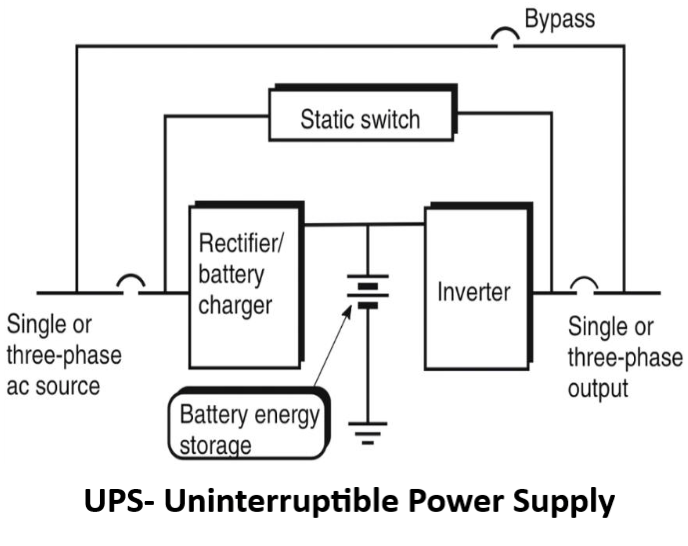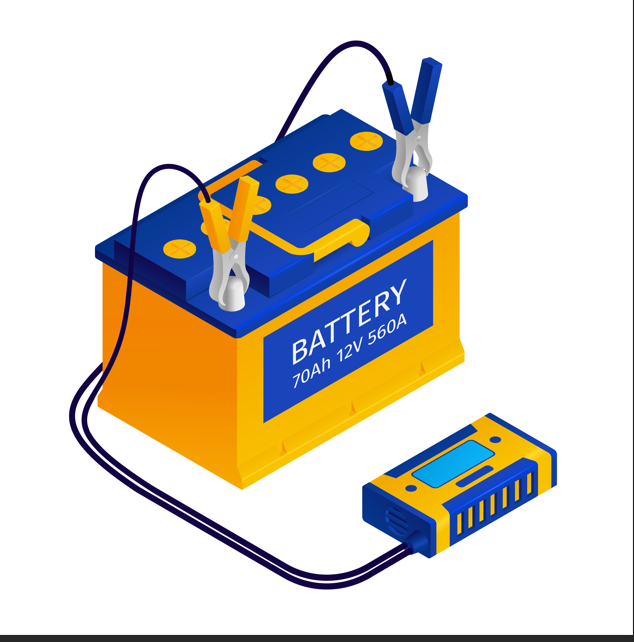Table of Contents
ToggleWhat is UPS and Full name of UPS?
UPS-Uninterruptible Power Supply
An uninterruptible power supply or uninterruptible power source (UPS) is an electrical apparatus that provides emergency power to a load when the input power source or mains power fails. A UPS differs from an auxiliary or emergency power system or standby generator in that it will provide near-instantaneous protection from input power interruptions, by supplying energy stored in batteries, super capacitors, or flywheels.
Working of UPS system

The on-battery run-time of most uninterruptible power sources is relatively short (only a few minutes) but sufficient to start a standby power source or properly shut down the protected equipment. It is a type of continual power system.
A UPS is typically used to protect hardware such as computers, data centers, telecommunication equipment or other electrical equipment where an unexpected power disruption could cause injuries, fatalities, serious business disruption or data loss. UPS units’ range in size from ones designed to protect a single computer without a video monitor (around 200 volt-ampere rating) to large units powering entire data centers or buildings.
The world’s largest UPS, the 46-megawatt Battery Energy Storage System (BESS), in Fairbanks, Alaska, powers the entire city and nearby rural communities during outages.
The primary role of any UPS is to provide short-term power when the input power source fails. However, most UPS units are also capable in varying degrees of correcting common utility power problems:
- Voltage spike or sustained overvoltage
- Momentary or sustained reduction in input voltage
- Voltage sag
- Noise, defined as a high frequency transient or oscillation, usually injected into the line by nearby equipment
- Instability of the mains frequency
- Harmonic distortion, defined as a departure from the ideal sinusoidal waveform expected on the line
Some manufacturers of UPS units categorize their products in accordance with the number of power-related problems they address. A UPS unit may also introduce problems with electric power quality. To prevent this, a UPS should be selected not only by capacity, but also by the quality of power that is required by the equipment that is being supplied.
Types of UPS system
UPS systems have three different topologies or categories based on what type of power protection you need they are
- Standby or offline
- Line – interactive
- Double conversion or online
An on-line UPS uses a “double conversion” method of accepting AC input, rectifying to DC for passing through the rechargeable battery (or battery strings), then inverting back to 120 V/230 V AC for powering the protected equipment.
A line-interactive UPS maintains the inverter in line and redirects the battery’s DC current path from the normal charging mode to supplying current when power is lost.
In a standby (“off-line”) system the load is powered directly by the input power and the backup power circuitry is only invoked when the utility power fails.
Most UPS below one kilovolt-ampere (1 kVA) are of the line-interactive or standby variety which is usually less expensive. For large power units, dynamic uninterruptible power supplies (DUPS) are sometimes used. A synchronous motor/alternator is connected on the mains via a choke. Energy is stored in a flywheel. When the mains power fails, an eddy-current regulation maintains the power on the load as long as the flywheel’s energy is not exhausted. DUPS are sometimes combined or integrated with a diesel generator that is turned on after a brief delay, forming a diesel rotary uninterruptible power supply (DRUPS).
A fuel cell UPS was developed by the company Hydrogenic using hydrogen and a fuel cell as a power source, potentially providing long run times in a small space.
Selection of UPS and battery banks
While selecting an UPS for a requirement, different manufacturers have different specifications, which make the comparison confusing. The comparison and selection should be based on the below technical parameters and the relevance for the particular requirement.
The 3 main components of the UPS are rectifier, inverter and battery. The rectifier acts as a load to the electrical mains and the following characteristic of the rectifier will decide the type of upstream infrastructure required.
Input current distortion (THDI) : Harmonics,
Input power factor,
Input start-up current,
Number of wires (3ph or 3ph+Neutral),
Efficiency (influences global efficiency),
Maximum output power,
Input voltage & frequency tolerances
Generator compatibility
The inverter of the UPS System will be a source for the critical loads connected to the UPS and based on the need of the load the following parameters decides the quality & capacity of the UPS.
Nominal apparent power (VA)
Nominal active power (W)
Capability to support load Power factor (low power factor and Leading mainly)
Inverter efficiency (influences global efficiency)
Output voltage distortion
Max load current crest factor
Overload, Inrush current and short-circuit capability,
With or without galvanic isolation
The battery is the heart of the UPS system and the selection of battery is more important as it decides the duration of operation in the event of mains failure. The battery also plays an important role in deciding the Capex and Opex cost. The following points have to be evaluated to have the right battery configuration.
KW considered for battery sizing
End cell voltage
Ageing factor (incase of low backup time)
No of battery bank in parallel
Design life of the selected battery
Required of charging current and its compatibility with UPS



I wish to show my love for your kind-heartedness supporting men and women who really want help on this one area of interest. Your personal commitment to getting the message throughout was exceptionally functional and have truly allowed many people just like me to achieve their pursuits. This invaluable help denotes a lot a person like me and additionally to my colleagues. Many thanks; from all of us.